
Shading solutions, such as overhangs and pergolas, help to block excessive sunlight during hot months while allowing sunlight to enter during colder months, thus maintaining comfortable indoor temperatures throughout the year.Building automation systems improve energy efficiency by optimising the operation of various systems based on real-time data, automating energy-intensive processes, and reducing waste through precise control of energy consumption.
What types of windows are best for solar gain?What are the benefits of enhanced operational efficiency in buildings?
Windows that are double or triple-glazed with low-emissivity (low-E) coatings are ideal for solar gain, as they allow sunlight to enter while minimising heat loss.Enhanced operational efficiency in buildings leads to reduced energy costs, lower maintenance expenses, improved asset longevity, and streamlined daily operations, ultimately resulting in a more sustainable and cost-effective environment.
Can passive solar design work in combination with active energy systems?How do building automation systems contribute to occupant comfort and productivity?
Yes, integrating passive solar design with active systems, such as solar panels or solar water heating, enhances overall energy efficiency and can significantly reduce energy costs.Building automation systems contribute to occupant comfort by maintaining optimal temperature, air quality, and lighting levels, which in tur
view of the Top Energy-Efficient Lighting SolutionsReview of the latest building automation systems
10 Benefits of Installing Green Roofs and WallsRoundup of top insulation technologies for residential use
The History of Sustainable Building PracticesWhy smart grids are the future of energy distribution
Why High-Performance Insulation Matters for Energy EfficiencyThe historical evolution of energy management systems
Why Water Conservation Techniques Are Essential in Sustainable BuildingWhat are energy-efficient appliances and their benefits
How to implement smart grids in urban areas